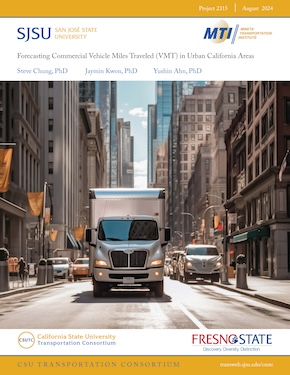- 408-924-7560
- mineta-institute@sjsu.edu
- Donate
Forecasting Commercial Vehicle Miles Traveled (VMT) in Urban California Areas
This study investigates commercial truck vehicle miles traveled (VMT) across six diverse California counties from 2000 to 2020. The counties—Imperial, Los Angeles, Riverside, San Bernardino, San Diego, and San Francisco—represent a broad spectrum of California’s demographics, economies, and landscapes. Using a rich dataset spanning demographics, economics, and pollution variables, we aim to understand the factors influencing commercial VMT. We first visually represent the geographic distribution of the counties, highlighting their unique characteristics. Linear regression models, particularly the least absolute shrinkage and selection operator (LASSO) and elastic net regressions are employed to identify key predictors of total commercial VMT. LASSO regression emphasizes feature selection, revealing vehicle population and fuel consumption as significant predictors in most counties. Elastic net regression, which balances feature selection and multicollinearity, expands the list of predictors to include variables like the number of trips, CO2 emissions, and PM2.5 pollution. Overall, the findings suggest that economic factors, such as fuel consumption and vehicle population, significantly impact the total commercial VMT across the counties. Pollution variables, specifically CO2 and PM2.5, also play a role. These insights underscore the need for nuanced transportation and environmental policies, especially in the face of economic fluctuations, to manage commercial truck VMT effectively and sustainably. Methodology using both LASSO and elastic net regression provides a robust framework for understanding these complex relationships in commercial transportation behavior.
STEVE CHUNG, PHD
Dr. Chung received his PhD in Statistics. He has been actively involved in many research fields including engineering, transportation, medicine, nursing, and data science. He has worked with students, faculty, practitioners, and professionals from Fresno State Transportation Institute, Community Regional Medical Center, UC San Francisco, Heart and Artery Center at Fresno, and Fresno VA Hospital.
JAYMIN KWON, PHD
Dr. Kwon has a background in environmental exposure science, with specific training and expertise in research on personal exposure assessment to air pollutants and data analysis on spatial and temporal variation of air pollutants. His current (STARTRAQ 2020) and recently completed (CHAPS) research include spatial and temporal changes of particulate matter and other air pollutants associated with fossil fuel combustion emissions, such as traffic. As a PI or co-investigator at several universities, NIOSH, and NIEHS/USEPA-funded grants, he constructed spatial GIS databases and analyzed the proximity effect of air pollutants.
YUSHIN AHN, PHD
Dr. Ahn is a member of the geomatics engineering faculty at California State University in Fresno, CA. He is an active member of the American Society for Photogrammetry and Remote Sensing and has been a certified Photogrammetrist since 2014. His research interest is remote sensing, mapping, sensor modeling/calibration, and geographic information system assisted data analysis.
-
Contact Us
San José State University One Washington Square, San Jose, CA 95192 Phone: 408-924-7560 Email: mineta-institute@sjsu.edu






